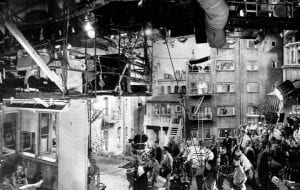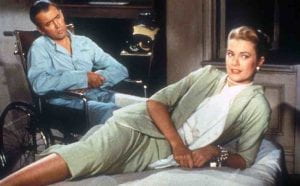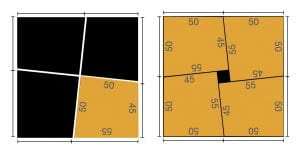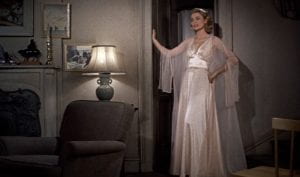
The Rear Window workshop was held in conjunction with an architecture theory seminar directed by Prof. Marcia Feuerstein, at the Washington-Alexandria Architecture Center of Virginia Tech. University. Prof. Feuerstein will direct the activities of the seminar during its engagement of this famous 1954 Hitchcock film masterpiece; the same resource materials will be made available to a group of independent collaborators interested in the film. This web page will serve as the hub for two separate but possibly interactive investigative communities.
Wikipedia: “Rear Window is a 1954 American mystery thriller film directed by Alfred Hitchcock and written by John Michael Hayes, based on Cornell Woolrich’s 1942 short story “It Had to Be Murder.” Originally released by Paramount Pictures, the film stars James Stewart, Grace Kelly, Wendell Corey, Thelma Ritter, and Raymond Burr. It was screened at the 1954 Venice Film Festival.
“The film is considered by many filmgoers, critics, and scholars to be one of Hitchcock’s best and one of the greatest films ever made. It received four Academy Award nominations and was ranked number 42 on AFI’s 100 Years…100 Movies list and number 48 on the 10th-anniversary edition, and in 1997 was added to the United States National Film Registry in the Library of Congress as being “culturally, historically, or aesthetically significant.”
aims of the workshop
The materials: the workshop will be based on (1) a position paper outlining the main issues of the film, with respect to the subjectivity of the Imaginary (perception; surveillance; visibility/invisibility) from a mainly ethnographic perspective; (2) a narrated video presenting key aspects of the paper, with examples, illustrations, and “puzzles”; and (3) zoom sessions for Q&A exchanges for the several “interest communities” that may spring up around this project. Shorter videos explaining key concepts will be added as the workshop proceeds. See the first one of these already posted, on Idempotency. An essay on what constitutes a masterpiece builds the case that Hitchcock, an auteur if ever there was one, could develop sophisticated techniques and motifs without necessarily being a “film theorist.” Watch a puzzle demonstration of idempotency to demonstrate the principle with shape rotations.

The ideas: Hitchcock clearly intended the analogy between the (diegetic) window of the action photographer Jeff Jefferies’ New York studio apartment, overlooking an interior urban courtyard, and the literal screen where the film itself is projected; where the audience, like Jefferies, is “immobilized” and treated to images that move in front of their front-directed looking. Other parallels become obvious. Like Jefferies, the audience is at first amused and entertained by what it sees; then it becomes intrigued by inconsistencies; then engaged in a suspenseful search for truth. Fictional truth is not the same as the “factual” of everyday experiences; in every way it is superior, in that it is a truth about our interest in truth, unrestricted by any rules of evidence or probability. In this way, as Slavoj Žižek tells us, the movies “teach us how to desire” by giving us a mirror-image view of how our desire grows out of the impulse to repeat, to configure the wishes of an imaginary Other, and to put ourselves in relation to these wishes. As this thesis develops, the position paper will undergo multiple revisions. This webpage will be the headquarters for all updates.
in preparation

No group of workshop participants can be expected to “be on the same page.” There will be, however, “key ideas” that serve as anchor-points for discussion and diversified ideas about the film. The anchors afford a maximum variability while sustaining the possibility of discourse. Without them, any project can be defeated by the pretense of “toleration for different views,” another expression for Relativism, which neutralizes and defeats any intellectual position on behalf of the false ideal of (impossible) consensus. Instead of this, the workshop relies on the principle of dissensus, summed up by the joke, “If you and I agree, then one of us is unnecessary.” A reference for this is Jacques Rancière, Dissensus: On Politics and Aesthetics, Steven Corcoran (ed., tr.), Continuum, 2010.
The idea of artistic genius meets with a lot of resistance in university classes required to look at works of art. The enjoyment of art is complex if only because the issue of enjoyment itself is complex. Read this introductory essay to see how to “get into” the work of art as a critical hedonist.
In the film Rear Window in particular, critics tend to throw around the word “gaze” a lot. Looking is indeed a critical element of the film, and Hitchcock refers directly to the parallel between the main character’s visual interests and investments and the film audience’s status as voyeurs looking through the imaginary “fourth wall” of cinema. While a generation of critics thought they were deriving their theories about the gaze from the French psychoanalyst Jacques Lacan, they were actually getting his theory of the gaze backwards, incomprehensibly. They were told this at a famous conference, where Joan Copjec (Read My Desire) explained the error and showed what film criticism could be like if it connected the gaze to how movies teach us how to desire. The gaze is something that comes from an unlocatable point in the object world, not from the subject, who desires what the Other wants him/her to desire. This is the gaze of the “evil eye” of envy, famous in folklore and present-day custom. See the essay by Todd McGowan† for an account of the gaze’s rocky history in theories about looking.
While the position paper and video are not required, they are presented as paradigms rather than manifestos, in hopes that participants will create their own versions, which can be collated and shared via this web page.
time frame
While Prof. Feuerstein’s seminar will have a defined schedule and time-limited interactions with the workshop materials, the larger project will continue without any specific limits. At some point, a blog will be used to supplement zoom Q&A’s. The archive of position papers and videos made by participants will be maintained for an extended period, in the view that Rear Window constitutes a kind of university as well as an imaginary universe of seen and unseen parts.
†Todd McGowan, “Looking for the Gaze: Lacanian Film Theory and Its Vicissitudes,” Cinema Journal 42, No. 3, Spring 2003.
links to materials
• The Retroactive Structure of Rear Window
This essay begins with a ramble on the geography and climate issues of New York summers, to establish a link between terrain, weather (temps), and tempo, yet Rear Window‘s set was entirely constructed in Paramount Studios in Hollywood. The aim is to interrogate the idea of the “where” and “when” of fiction, and how the space-time of a murder mystery story synchs up with our sympathetic nervous system. The equally important issues of anamorphosis, and automaton/tuchē can hopefully be addressed by the video or a coda to this paper. The fundamental background (primary sources) for this speculation are the psychoanalytical subjectivity defined by Jacques Lacan.
We typically have trouble with the terms “genius” and “masterpiece.” To be relativistic, we fall back on the doctrine of à chacun sa lumière (each to his/her own light) or the Latin de gustibus non disputandum (“there’s no debating taste”). However, recognition of the reality and operational functionalism of genius is critical to being critical, so this essay attempts to address the complex issues surrounding enjoyment itself.
• “Rear Window: Ex Falso Sequitur Quodlibit“
A review of Rear Window as a story taking place in projective virtuality introduces three interlocking terms: anamorphosis, projective geometry, and the fourth wall. A fourth linking idea is “idempotency,” the ability to use change to remain the same. The video is available on YouTube.
This silent video is about the relation of the “ex falso” principle to anamorphosis, projective geometry/virtuality, and the function of the fourth wall both in spatial folding as well as artistic reception/understanding. Hitchcock’s 1954 film is a masterpiece both in terms of the cinematic history of the single-set drama and architecturally, in the way the plot spells out how projective space works, converting Euclid’s “impossible” vanishing points into objects of desiring. “Rear Window” teaches us to desire by showing how desire is “in the air,” a way we breathe in an atmosphere, a TEMPO.
Other instructional videos introduce ideas that will be generally novel for most audiences: idempotency, “cyclopean” function of the hearth, the labyrinth as architectural emblem for the universal period “between the two deaths,” the topology of affinity/equalization, and other topics.
This video considers the space of perception from the (Lacanian) point of view, that visibility implies invisibility and looking involves being looked at, AT THE LEVEL OF CONSCIOUS RECOGNITION (the “Symbolic,” in Lacan’s terms). This makes the visual field of the “speaking animal” (Lacan’s $, or barred subject) charged by the overlapping forces of the gaze and the subject of representation. A fuller understanding requires the insight that Euler circles are not the same as Venn diagram circles. A Venn diagram can depict anything in Boolean logic, but an Euler circle restricts itself to “what can happen in reality.” This makes it the perfect device to map the Real, because it produces a precise outline of the real in the case of two circles whose union does not intersect, and where there is a “symmetrical difference” that represents, simultaneously, resistance and affinity.
• Coda: How is Language Different from a Code?
This is a footnote to the video essay, “What Is a Mirror?” You may want to look up some of the references, such as Lacan’s intersecting triangles in The Four Fundamental Concepts of Psychoanalysis, the definition of the Klein Group, or the difference between Euler circles and Venn diagrams. Also, it helps to know something about the Borromeo knot and Edgar Allan Poe’s masterpiece, “The Purloined Letter.” Knowing how to do Gauss encoding of a knot would be an extra, not required this time. [The analysis of “The Purloined Letter” is based on Richard Kopley, Edgar Allan Poe and the Dupin Mysteries, Palgrave Macmillan, 2011.]
• How to Demonstrate the Concept of Idempotency to Yourself
This is a little magic trick mathematicians like to use to demonstrate the hidden powers of the palindrome. Before you watch this, write down any three-digit number so that the first digit is larger than the last. In most cases, if you follow the instructions, you will reach an answer that I might write down and place in a sealed envelope before you make your calculations. It’s 1089. The relation to idempotency is clear: the answer will stay the same no matter how one varies the digits. The “idempotency device” is the internal palindrome that negates by reversing (“mirroring”) the order of the numbers and then mirroring the mirroring. The result is not a cancelation of the negative but the revelation of a “hidden order” that remains constant in the face of variation.
• Seminar schedule (Feuerstein)
The WAAC seminar component of the Rear Window workshop will be posted here.
• Extras
Related videos, independent source materials, appendices, contact lists of participants.
-
- definition and elaboration of the idea of idempotency
- Voyeurism issues in Rear Window
- New York State voyeurism law (2018)
- proof countering Pallasmaa’s claim that Lisa’s nightgown was “overtly provocative” and “diaphanous”

- an experiment to demonstrate idempotency
- a quick way to connect idempotency to kenosis
- definition: “criticism by the cut“
- desargues’ theorem animation
• Rear Window Workshop Blog (forthcoming)
Within definite time windows, the workshop will host blog discussions following the publication of materials calling for active discussions.